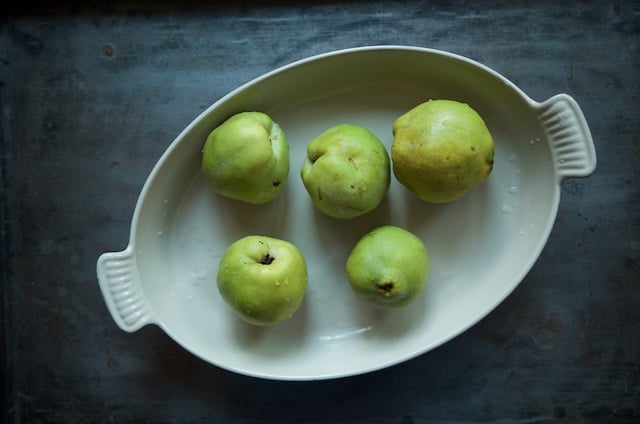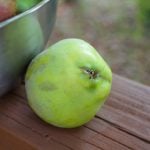A small batch of sugar-sweetened roasted quince butter is a tasty preserve for the fall canning kitchen.

Back in September when I was in Portland, my mom and I drove out to Sauvie Island for a picnic and a walk. The day was crisp and sunny, and we both felt buoyant and energized by the gloriousness of the day. After we’d eaten, we went for a wander around the antique apple orchard at the old Bybee-Howell House.
A maintenance worker was there raking up the fallen apples. We asked if we could gather a few of the windfalls that were still in good shape (as we’ve been doing for years) and were told that they were headed for the compost and to help ourselves. I filled a bag with bruised but flavorful fruit and was entirely satisfied with my haul until I spotted a single quince laying on the ground amidst the apples.

The game had gotten real. I love quince. And this year, they’ve been particularly hard to come by on the East Coast, in large part thanks to the wonky weather we had earlier in the season. So finding untended and unappreciated source for quince was a thrill. My scavenging went from casual stroll to focused searching and my determination paid off.
I finally found the single quince tree. There was a bounty of quince on the ground and I picked up every single one worth salvaging. While I was still in Portland, I made a batch of apple and roasted quince butter, using all the apples and the about half the quince (all that wouldn’t travel well). The rest of the quince? I bagged it up and brought it back to Philly with me for a batch of roasted quince butter.

Because quince is incredibly dense and unyielding when raw, I bake it until soft before I try do anything with it. This step doesn’t fully cook the fruit, it just softens it enough that you can cut into it without fear that the knife will bounce and slice your finger instead. It’s not the right approach if you want to make jelly with it, but it’s wonderful if you are planning to make jam, butter, paste or chutney.
Once it cools down from the oven, I cut away any remnants of the blossom, cut the quince into eighths, dump it into a saucepan, and simmer it with water until tender. Finally, I fit a food mill with its finest screen and push the cooked quince through. When that’s done, you’re left with a dense, fragrant, tart puree that is ready to be cooked, sweetened, and spiced into the preserve of your liking.

For this batch, I opted to sweetened with sugar and spice with cinnamon, nutmeg, ginger, and cloves. It is fragrant, smooth, and spreadable. I really like to spread a thin layer on a slice of craggy toasted sourdough and then top it with whispers of a well-aged farmhouse cheddar. Paired with a mug of tea, it’s the perfect afternoon pick-me-up (and makes me feel like perhaps I’m traveling in time to a less complicated era).
How have you been preserving quince this season?

Roasted Quince Butter
Ingredients
- 2 pounds ripe quince it should smell fragrant and floral
- 3 cups water
- 2 cups sugar
- 1 teaspoon cinnamon
- 1/2 teaspoon nutmeg
- 1/2 teaspoon ground ginger
- 1/4 teaspoon ground cloves
Instructions
- Preheat the oven to 350 degrees F. Set the quince into a baking dish and pour a bit of water into the bottom. Bake the quince for 25-30 minutes, until they can be pierced with a dinner fork.
- Remove the quince from the oven and let them cool. Once you’re able to handle them without burning yourself, cut away any remnant of the blossom and then cut the quince into eighths.
- Place the cubed fruit into a sturdy saucepan with a tight fitting lid and add the 3 cups of water. Set the covered pot on the stove over a medium-high heat and bring to a boil. Reduce the heat to medium-low and simmer the fruit until breaks down into a chunky sauce.
- Fit a food mill with its finest screen and push the quince sauce through. Work the food mill until all you have left are seeds, skins, and core material in the top.
- Rinse out the saucepan to remove any scummy residue and return the puree to the pot. Add the sugar and spices and stir to combine over medium heat. The butter will need constant stirring at this point, or it will splash all over your stovetop.
- Typically, I’m quite pleased with the consistency at this point, but if you find that it is too runny for your tastes, continue to cook, stirring all the while, until it reaches your desired thickness.
- For a perfectly smooth butter, use an immersion blender to even out the texture just before canning.
- Funnel the butter into clean, hot jars, leaving 1/2 inch headspace. Wipe the rims, apply the lids and rings, and process in a boiling water bath canner for 15 minutes.
- When the time is up, remove the jars and set them on a folded kitchen towel to cool. When the jars have cooled enough that you can comfortably handle them, check the seals. Sealed jars can be stored at room temperature for up to a year. Any unsealed jars should be refrigerated and used promptly.

This recipe is absolutely amazing! This will become a family favourite….its autumn/winter in a jar. I am glad that i have more quinces as i think i want to make another batch. I was worried that the cloves would be too overpowering but the spices are just right. Thank you!
I am so glad you like it!
Hi, Marisa. I just made what I call “quince sauce” with vanilla bean and a bit of cardamom. Looks just like your butter! I may rename mine! I’ll be harvesting the last of my quince this week, and will try your method.. Thanks!
I made an accidental quince butter when I tried to make membrillo and I’m in love. I don’t particularly like cloves, so think I would sub cinnamon? Vanilla? Let me know your thoughts lol
Thanks so much!! I love your blog and books
Vanilla would be delicious.
I like the method of roasting first, but when I milled the fruit with a finegrain it was still full of grainy core. It took two passes through a sieve to strain out all of the grainy crunchy core and get a decent consistency. Next time I will roast, but then core it before cooking. I like the pectin and color from the seeds, but I will put them in cheese cloth or something and add it during the cooking to try and extract that without getting that grit all through the cooked quince.
Sorry that it didn’t work as well for you as it did for me.
Just made this yesterday. I am from Portland and had no idea we had quinces there – my cousin sent me a box from LA. I was lucky that most of the butter made it to the jars – my 91 year old dad loved this so much- it reminded him of my grandma’s.Thanks for the great recipes – have all your books and consider them among my prize possessions!
I am so happy that this quince butter brought back good memories for your dad! And thank you for the kind words about my books!
I’d love to try my hand at this but sadly do not own a food mill. Is there a way I could do it without one? Thanks for the lovely recipe!
I had a bumper crop of quince on my tree this year — more than 200 (yes, I counted). I would’ve shared with you in September as I live in Portland. I make quince paste every year I tried a new method this year: I baked them, then cored, processed in the food processor until really smooth. I weighed the quince puree and added an equal weight of sugar and cooked it all until thick, about 30 – 45 minutes. Then I put it in half-pint wide-mouth jars and processed in a water bath for 10 minutes. It worked brilliantly!
I still have a few quince left and will try your recipe — it looks and sounds yummy.
Oh my goodness, baking before chopping? You’re brilliant! It takes sooo long to prep raw quince.
I made quince jam with this year’s haul from our farmers’ market. Looking forward to trying quince butter … sigh … next year.
I agree, sounds lovely but I have never tasted quince either. May have to hunt for some to try.
Mmmm, looks wonderful!! I’ve never tasted quince.
I was just putting my quince jam from “Use Real Butter” in the canner when I looked up your site to see how long to precess my 8oz. jars. In that recipe you grate the quince with the peal and I wasn’t happy with the finished texture. So I used the immersion blender to get a smoother consistency. Next time I’m trying your method and putting it through my food mill. I’ve never eaten quince before. It has a lovely floral flavor and is really good with cheese.